Editor's Note: This post was originally published October 2019, and has since been updated for accuracy and relevancy.
Which works better: discount codes or automatic onsite discounts? “That’s always the big question,” says Chuck Mazzone, the Digital Marketing Director at Out of Print, which sells out of print book covers on t-shirts, totes, and accessories. Mazzone and his team have spent nearly a decade testing discounting strategies.
The right type of discount can maximize sales. Ninety-seven percent of retailers cite discounting as their top pricing strategy. But using the wrong type of discount can result in adverse consequences. Not only can the wrong discount reduce profits, but it can also devalue your brand.
Use this guide to offer the right type of discount, to the right customer, at the right time.
- What’s the difference between discount codes and automatic discounts?
- The psychology of discounting
- Top-performing discounts you can use today
- Discount strategies and tactics
- When to use discount codes vs. automatic discounts
What’s the difference between discount codes and automatic discounts?
The right approach to discounting hinges on what you sell, the customers you target, and the brand experience you wish to create. Specifically, will your target market be more inclined to purchase with discounts that appear automatically at checkout? Or might they be more persuaded to buy after receiving a discount code they must enter during the checkout?
Your choice boils down to offering a self-serve discount model (consumer manually enters a code) or setting up your online store to automatically apply discounts for the shopper.
Discount codes
Discounts can take the form of a fixed value, percentage, or discounts on products, collections, or variants in their stores. Importantly, discount codes give you strict control over pricing and promotion:
- Increase your average order value (AOV) with discount codes that give customers “buy X get Y” discounts
- Limit the life of a particular discount code by specifying the dates for which the code is valid
- Protect your brand and profit margins by limiting the number of times a code can be used, the minimum spend amount before the code can be used, and to which products, collections, or variants the discount can be applied
Even better, brands with an omnichannel retail strategy can let customers either redeem their discounts in an online store or in a brick-and-mortar retail location. Discount codes may be used to:
- Track conversion performance of social media influencer partnerships
- Promote a sitewide discount in a banner for anyone visiting your site
- To improve your customer service or abandoned cart email campaigns
Learn how you can use discount codes to increase Instagram referral sales 300% from influencers.
Out of Print offers a sitewide discount code to first-time shoppers and those leaving who have not yet made a purchase.
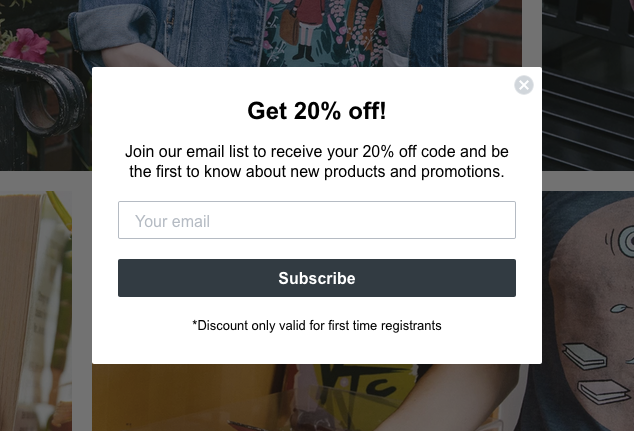
“It’s an incentive to make that first purchase,” Mazzone says. “But we’d rather shoppers focus their attention on our products instead of doing the math in their head and calculating the final price.”
Pros of discount codes
- Discount codes may be used to create a feeling of exclusivity in the customer’s mind. Targeting specific customer segments with unique discount codes based on purchase history can create a more intimate, personalized brand experience and signal that you truly understand what your target market values.
- Discount codes prevent over discounting your products since you control who gets the discount and when.
Cons of discount codes
- Customers must manually enter the code to receive the discount. This adds a step to the checkout process which can cause shoppers to abandon cart. It can also add friction as consumers may mistakenly type the wrong code or copy and paste an incomplete code received via email or from a site pop-up or banner offer. Discounting can also cause consumers to perceive your brand as less valuable.
- Discount codes may be shared online without your permission and reduce profits
Automatic discounting
Investigate whether your commerce platform has native automatic discounting capabilities. You should be able to offer your customers discounts that apply automatically at checkout and in the cart. Create percentage, fixed amount, or buy X get Y automatic discounts.
Even though discounting is automatic, the rules you set give you plenty control. For an automatic discount to apply correctly, your customers need to add all eligible items to their carts before they move to checkout. This includes:
- The items that they need to buy to qualify for the discount
- The items that they get as part of the promotion
Importantly, Shopify Plus has built safeguards to prevent discount abuse. Specifically, automatic discounts take precedence over discount codes meaning customers can't apply multiple discounts to a single order. Discount codes are unavailable for customers who have an automatic discount applied to their checkout.
Automatic discounting may be used to:
- Show customers the markdown at the checkout so they can see the value they’re receiving
- Strike out the original price and show the promotional price to visually represent value customer is receiving
- Increase the flexibility of promotions by customizing discounts by adding a minimum purchase amount or quantity of items or set conditions to only apply the discount to specific collections or products.
“Offering automatic discounts is much more seamless than sending customers discount codes they have to enter manually,” Mazzone says. “With more and more purchases being made on mobile devices, it’s more difficult to enter a code. The real benefit with automatic discounts is that it does the work for the customer and means they have one less thing to worry about.”
Thousands of brands use Shopify Scripts to automatically apply 15 attractive discounts to increase sales. Similarly, Shopify Plus brands can also use Launchpad to schedule discounts in advance.
The original price is “struck out” and displayed next to the discounted price and shown everywhere from the product page to the checkout. When the discount period is over, Launchpad automatically rolls back the discount and restores the original pricing.
Pros of automatic discounting
- Eliminates data entry work for the customer required by discount codes.
- Limited-time promotions inject urgency into the buying decision.
- Because discounting is automated, it reduces the number of steps in the checkout process which can increase your conversion rate.
Cons of automatic discounting
- Consumers may not feel they are getting an exclusive or personalized promotion as they might with a targeted discount code.
- Unless you communicate the limited-time nature of your discount, the customer may not feel a sense of urgency and purchase immediately.
The psychology of discounting
Coca-Cola was the first brand to hook consumers with discounts in 1887. The very first coupon, which was redeemable for a free glass of Coke, would shape the future of commerce. The science underpinning the very first discount is still at work today online—receiving discounts releases oxytocin and makes us happier.
Besides increasing sales, discounts can discourage consumers from abandoning their online shopping carts. The opportunity to redeem a coupon also motivates consumers new to your brand to make their first purchase. However, pricing psychology, or the strategy behind how you price your products, goes beyond the dollars saved. Discounts are only part of the purchase decision and must be considered with:
- The cost of the goods being sold
- The price competitors charge
- The supply and demand for the product
With these inputs in mind, marketers can leverage discounts with what’s commonly known as anchoring bias, or our tendency to rely too heavily or anchor on a single piece of information when making a decision. With discounts, marketers aim to anchor consumers to the original, higher price. Introducing a discount, which reduces the price, can cause the consumer to perceive the product as more valuable. If the three aforementioned bulleted inputs allow, marketers may even set product prices artificially high, which can cause consumers to perceive the very same discount as even more valuable.
According to a recent McKinsey & Co survey of global consumer sentiment during COVID-19, consumers are more mindful of spending habits right now due to the combination of the pandemic, job insecurity, and ongoing economic uncertainty. 40% of Americans report being more mindful of where they spend their money, with 32% saying they are moving to value brands and less expensive products to save money. Similar patterns exist all over the world.
Globally, consumers have shifted their spending to focus largely on essentials, such as groceries and household supplies, and have cut back on more discretionary categories, like travel, jewelry, and consumer electronics.
Black Friday is a prime example of when discounts are prominently displayed. The marketer’s job is to anchor you to the original price: The bigger the discount, the bigger the bargain.
Flash sales offer a discount or promotion for a limited period of time. This drives shoppers’ fear of missing out (FOMO) and the sense of urgency and exclusivity encourages impulse buying.
The anchoring effect can cause consumers to purchase items they don’t need simply because they perceive the bargain they’re getting is too good to pass up.
Careful use of flash sales can allow your brand to control your own peak seasons and product release dates, instead of relying on a few big shopping seasons per year.
Deep-discount sales of short duration (three-hour flash sales seem to be the sweet spot) are effective at increasing traffic, conversion rates, and revenue for short-term wins. When done right, flash sales can increase customer lifetime value as well, for longer term gains.
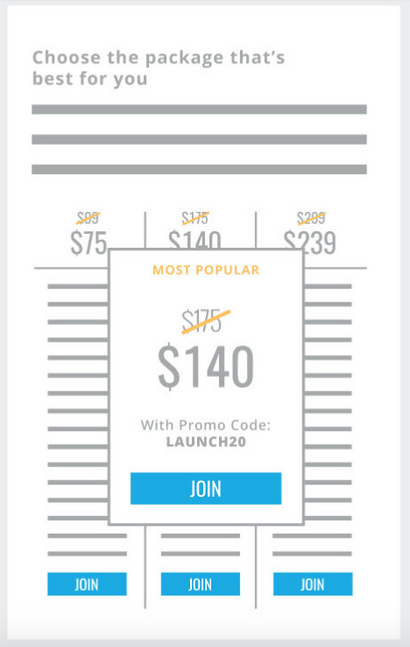
In fact, the anchoring effect can trigger another powerful psychological principle: our desire to seek pleasure and avoid pain. Since passing on a bargain can lead consumers to feel pain, or at minimum foregoing the pleasure of experiencing the thrill of a great deal, shoppers are often inclined to complete purchases to avoid the unpleasant feeling of missing out on a deal others are enjoying.
Separately, there’s much debate around the right way to discount different products:
- For items priced under $100, research suggests discounts should be presented as percentages rather than dollars for items priced under $100
- For higher value or expensive items, research suggests using round numbers with lower priced products and precise prices with higher value or expensive items
“We’re always evaluating how customers respond to our discounts,” Mazzone says. “What we’ve learned over the years is that different types of discounts work better at different times of the year.”
More on properly timing your discounts later in the piece.
For now, no two target markets are the same. Likewise, neither are any two product catalogues. So split test your discounting tactics and allow the results to drive your strategy. Here’s a list of potential discounts you can experiment with.
What’s most likely to work and result in a lift in sales?
Below are some of the top-performing discounts Shopify Plus brands use to lift holiday sales and power major campaigns year round.
Top-performing discounts you can use today
Before offering a discount, clearly define what you want to achieve with the discount. Goals may include:
- Acquire new customers
- Increase sales
- Earn repeat customers
- Get rid of unsold inventory
“Inventory always plays a role when considering whether to discount,” Mazzone says. “We’re always conscientious about inventory levels before discounting. If inventory is low we don’t discount. That way we don’t sell product we don’t have and disappoint customers.”
With your objective in mind, it’s crucial to segment customers so you can offer discounts (via email etc.) based on preference or purchase history. Segmenting customers prevents you from sending them an irrelevant discount code. It also saves time and money spent on email or PPC ads directing them to an irrelevant or impersonal promotion.
NOTE: Segmentation may play less of a role depending on your goal (e.g. moving unsold inventory quickly). It may also be less of an emphasis during major campaigns or sitewide holiday sales aimed solely at lifting sales or acquiring new customers.
With a clear goal and customer segments identified, consider experimenting with traditional discounting techniques like bundling, volume, prepayment, and seasonal discounts. We’ll share some of the top-performing discounting techniques Shopify Plus brands are using:
Discount #1: Buy one, get one free (BOGO)
The popular BOGO discount is one of our top performers. It has also evolved as brands use it creatively to offer multiple freebies or incentives. For example, AAF, a leading provider of patriotic apparel, uses BOGO discount codes via a hero image and lets customers pick their own discount:

You can mix and match products of your choice, turning them into creative promotions to reward existing customers and boost sales. Buy X/Get Y quantity (50% off or 1 free), shipping, and other discount types all provide more flexibility for building loyalty programs as well. Track your discounts to which are performing best so you can repeat your biggest successes.
Discount #2: Free gift with purchase
Small, unexpected gifts can be a cost-effective way to convert customers and earn loyalty. For example, club and festival apparel brand INTO THE AM, uses a pop-up to automatically offer a free gift to shoppers who add particular items to their carts. Not only is the gift tailored to the item the shopper has added to their cart, but the company also lets the customer choose their favorite gift:
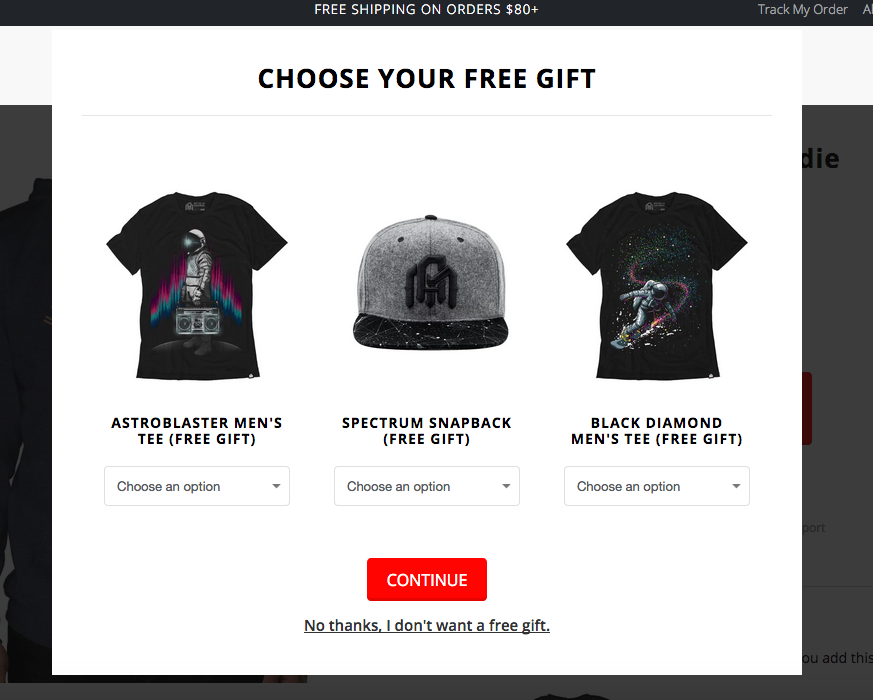
The brand’s sister company, Emazing Lights also adds a free, lightweight item that doesn’t impact shipping costs and can fit into flat rate containers for customers who reach a certain purchase threshold.
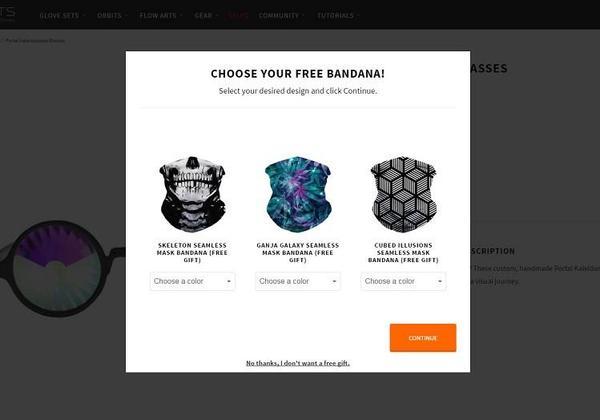
Similarly, Hypnotik, formerly known as MMA Warehouse, uses an inventory counter that displays alerts like, “Only 2 left in stock!” to add urgency for their shoppers. The company also uses automatic discounting to give a free water bottle to customers who purchase certain products:

Discount #3: First-time customer discount
Acquiring new customers is expensive. Most first time visitors will leave your site without making a purchase. In fact, it takes a visitor just 13 milliseconds to judge your site, so making a good first impression matters more than ever.
It’s why top-performing brands often offer new shoppers a discount. Evy’s Tree, a luxury hoodie company, wanted to make checking out easier by reducing the number of clicks. So they use Shopify Scripts to calculate discounts in real-time, automatically excluding sale items and presenting the customer with the lowest price.
Using a bit of JavaScript, you can even call attention to the discounted item so that it might display something like this, all without coupon codes:
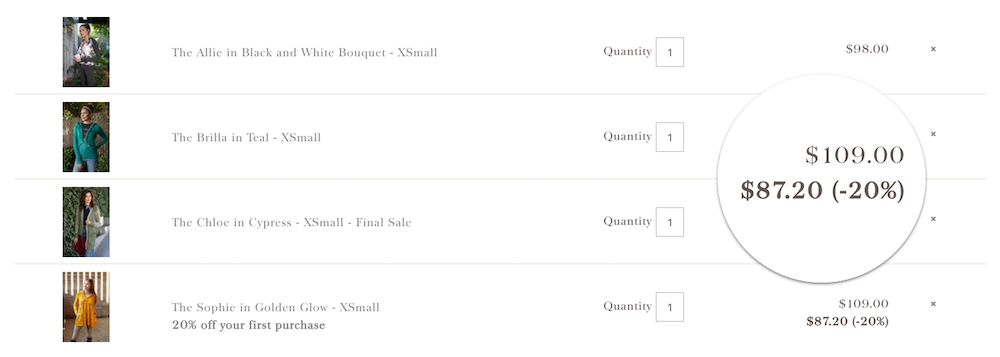
Discount #4: Tiered discounts by spending thresholds
Offering discounts to big spenders can actually increase their customer lifetime value. Luxury bedding brand Boll & Branch does this in a variety of ways, including offering new customers a discount on their first purchase, but only if they spend $150 or more:
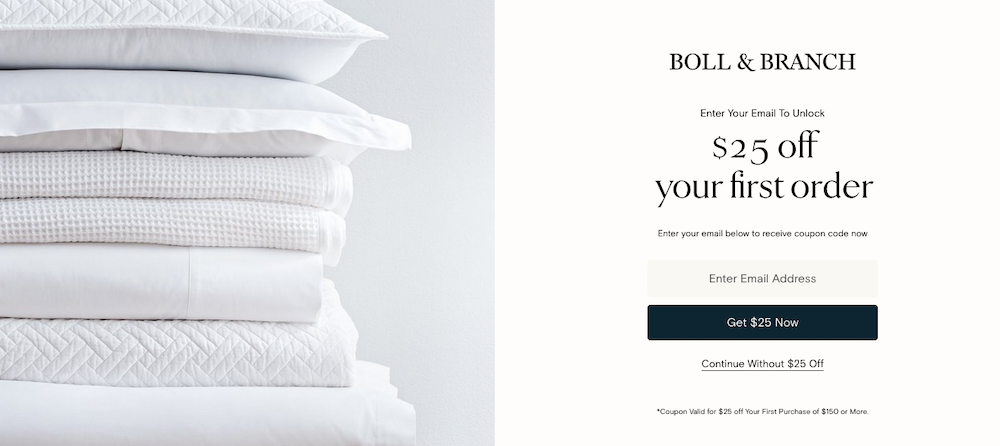
MMA apparel and training gear brand Hypnotik also relies on automatic discounting that offers customers a free gift at the checkout upon meeting a certain spending threshold:

To determine the appropriate spending threshold, calculate your median order value (MOV) or average order value (AOV) and build your tiers accordingly. Establishing a spending threshold above these levels ensures that the discount results in customers adding more items to their carts than they otherwise would have.
Discount strategies and tactics
What will be the most effective discount strategies and tactics going into the Black Friday Cyber Monday period? Serving the right discount, to the right shopper, at the right time is the ultimate goal. Brands that routinely achieve this goal constantly test different discounts at different times to optimize in time for the holidays.
“We’re constantly experimenting and trying out different discounts,” Mazzone says. “Our goal is to have months of learning under our belt so that when the holidays roll around we have best practices in place.”
Importantly, Mazzone has learned different types of discounts are more effective at certain times of the year. Remember, Out of Print’s target market of book lovers includes educators and librarians. These customers are targeted in what the company calls major moments, like back to school, National Library Week, or Banned Books week.
Likewise, Out of Print strategically times BOGO discounts on T-shirts when spring begins. Toward the end of the calendar year, the company offers discounts on smaller items that are perfect Christmas stocking stuffers.
Besides timing, Out of Print suggests it’s also crucial to test and optimize how discounts are implemented, what’s discounted, how long discounts run, and how they’re presented:
Sitewide vs. specific collections
Out of Print launched predominantly as a T-shirt company. It has since grown to offer totes, socks, mugs, and accessories. With so many categories, shoppers might fall prey to the paradox of choice if offered a storewide discount. To focus customer attention, Mazzone suggests discounting specific product collections. Out of Print often highlights its Harry Potter, Sesame Street, and Star Wars collections with targeted discounts. Each has become a top seller.
What to discount
Buyer behavior becomes a key ingredient in discounting success. For example, while Out of Print has had success offering BOGO discounts on socks, not all consumers buy their socks in pairs. After analyzing the sale, Mazzone says he learned many customers prefer to purchase their socks in bulk, 3–5 pairs at a time, and may not be motivated by an online BOGO offer.
Discount duration
Highlighting certain deals during specific times of the year is only part of the equation. Discounts should act as a motivator and result in accelerated or incremental purchases. You’ll undercut your margins if you train customers to wait for a discount. Your promotions will also lack urgency if they’re perceived as open ended. Out of Print routinely experiments with discount duration. Campaigns aligned with a specific catalyst like “Banned Books Week” are often more effective when they last a week. Other campaigns promoting a new release often perform better if they last just 48 hours.
Timed discounts
A timed discount is another FOMO-based strategy to motivate shoppers to buy immediately. With these discounts it’s all about scarcity and the ticking clock, as the number of discounts available, and/or how steep the discount is, decreases over time.
For example, for the first hour of the sale, the available discount might be 20%, and then it would decrease by 1% every hour for the next 10-12 hours until the sale ends. This incentivises consumers to shop early to get the biggest discount on the biggest shopping carts.
Likewise, these sales can be run on volume, and set up as a descending scale. Surf brand Rusty used this kind of sale for a one-day, sitewide promotion. They offered 10 coupons for 50% off, 20 for 40%, 30 for 30% off, and 50 coupons for 20%. This kind of limited availability of discounts for the first-come-first-served ramps up the urgency for the consumer: Can they be one of the lucky ones who gets the best deal?
Sforce used a similar combination of scarcity and urgency to drive a significant sales increase during the Black Friday Cyber Monday sales period.
The store decreased the sale percentage they were offering every couple of hours over the four-day sale event. Each product had a countdown timer attached to it which created urgency as customers saw the timer ticking down on the availability of the current discount.
There was also limited stock the business was prepared to sell at each discount tier. This introduced an element of scarcity as stock was finite within each sales tier, and the merchant made clear to customers how much stock was left for each product during each discount period.
Discount presentation
Don’t take sides in the “dollar off vs. percentage off” debate. Out of Print uses both based on the segment being targeted. For example, first time visitors to the site are offered a percentage off discount code. Mazzone suggests consumers not as familiar with the brand’s products or pricing are often more influenced by a large number framed as a percentage. Conversely, repeat customers with a better grasp of the company’s pricing often respond better to dollar off discounts or promotions such as “$20 T-shirts” or “3 T-shirts for $50”.
“Our conversion rates are much higher when we automatically discount versus when we send customers discount codes,” Mazzone reveals. “It’s a hassle-free checkout for the customer and results in better sales for us.”
When to use discount codes vs. automatic discounts
Discovering a successful pricing strategy requires experimentation. It also requires a customer-centric approach that includes:
- Identifying when to use discount codes vs. automatic discounting to maximize sales
- Testing top-performing discounts like BOGO, free gift with purchase, and tiered promotions based on spending thresholds
- Incorporating best practices that weighs sitewide vs. collection discounts, discount duration, and presentation
Nearly every brand plans to discount. Not all will invest the time to fine-tune their approach. Those that do will earn customer loyalty and more sales.






